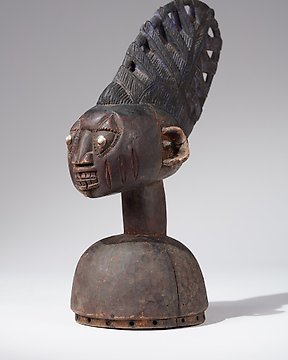
Joruba - Nigeria (Ingen reservasjonspris)
Nr. 83341953

Nr. 83341953

A Veranda by Agbonbiofe Adeshina (Efon-Alaye, c. 1880 - 1945). It seems to be an early work, we suggest a date well before 1912. The figures are not yet as "sharp-edged" as in his later work, the heads are still somewhat rounder and do not yet sit on the later gently curved neck. Everything seems a little squat, but Adeshina's very special expression is already clearly discernible. It is the curved hairline resp. head crest, the pursed lips, the horses' "knobbly" nose, their small ears, the beaded bridle. It is extremely unusual that the king was depicted twice on top of each other on a veranda post. This form of depiction is utterly unique. Early 20th centuzry. Incl. certificate of origin and provenance.
Agbonbiofe Adeshina also carved the posts for the Yoruba royal palace in Efon-Alaye (1912-1916), where they supported the roof of a veranda lining the king’s reception courtyard.
"The sculptor Agbonbiofe was the most prominent of the Adeshina family of artists from the town of Efon-Alaaye, during the first decades of the 20th century." Saint Louis Art Museum.
"Most of the African master carvers remain unidentified. But some artists are known, and are still remembered and celebrated today. Agbonbiofe, a member of the famous Adeshina carver family, is one of them." Minneapolis Institute of Art.
Lit.: "Acquisitions of the Art Museum 1993", Record of the Art Museum, Princeton University 53, no. 1 (1994): p. 46-95., pp. 93–94 (illus.) Peter Mark, "Is There Such a Thing as African Art?," Record of the Art Museum, Princeton University 58, no. 1/2 (1999): 7–15., p. 14, fig. 6 "Selected checklist of objects in the collection of African art," Record of the Art Museum, Princeton University 58, no. 1/2 (1999): p. 77–83., p. 83. Milwaukee, Wisconsin, Milwaukee Public Museum, Selections from The William W. Brill Colllection of African Art, 1969: 24, catalogue of the exhibition, Milwaukee Public Museum, May 5 - August 31, 1969 (for additional venues see bibliography, Milwaukee 1969). The Housepost with Mounted Warrior by Agbonbiofe Adeshina, For the Palace of the Alaaye of Efon, Efon-Alaaye, Ekiti, Nigeria Edwin and Cherie Silver, Los Angeles, acquired in 1971. John Pemberton III, Art and Rituals for Yoruba Sacred Kings, Art Institute of Chicago Museum Studies, Vol. 15, No. 2 (1998). Alisa LaGamma, Authorship in African Art, African Arts, Vol. 31, No. 4, Special Issue: Authorship in African Art, Part 1 (Autumn 1998). Alisa LaGamma, Beyond Master Hands: The Lives of the Artists, African Arts, Vol. 31, No. 4, Special Issue: Authorship in African Art, Part 1 (Autumn 1998).
Other pieces of Agbonbiofe Adeshina:
Minneapolis Institute of Art
Saint Louis Art Museum
British Museum
The Cleveland Museum of Art
Ackland Art Museum
Sothebys, the collection, Edwin and Cherie Silver, lot 59.
Hvordan kjøpe på Catawiki
1. Oppdag noe spesielt
2. Legg inn det høyeste budet
3. Å gjøre en sikker betaling